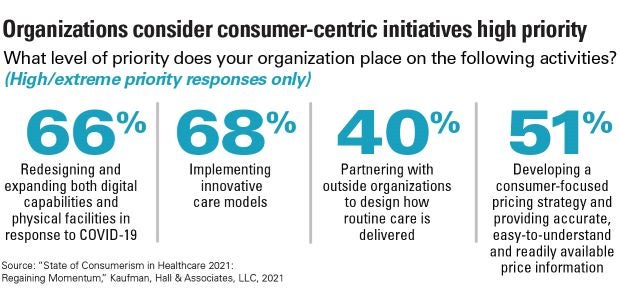

Digital Strategies Stall as Disruptors Advance

In the marathon that the COVID-19 pandemic has become, hospitals and health systems set a brisk early pace in transforming digitally. Telehealth services scaled rapidly as organizations adopted clinically integrated digital strategies and shifted how and where they deliver services.
That momentum, however, has stalled as telehealth use dramatically leveled off since the pandemic’s peak, according to the Kaufman Hall 2021 Healthcare Consumerism Survey.
In short, despite the significant progress that’s been made, relatively few organizations are outpacing the market in meeting the expectations of increasingly sophisticated and tech-savvy consumers. Meanwhile, threats continue to mount from well-resourced tech competitors and retailers as services increasingly move from acute care to home-based settings.
Competitive Threats Mount
This is especially evident in primary care, with accelerating expansion and market segmentation and increased activity from retailers like CVS Health/Aetna, Walmart and Walgreens. Meanwhile, large tech companies like UnitedHealth Group/Optum, Amazon and Apple are increasing their health care delivery presence.
Most of the 110 responding executives, who represent 95 health care organizations, voiced concerns about disruptive threats posed by payers and tech companies like UnitedHealth Group (92%), CVS Health (92%) and Amazon (78%). Companies offering new primary care models such as One Medical and insurers like Oscar Health also were viewed as competitive threats by 82% and 77% of respondents, respectively.
Repositioning for the Future
Amid this backdrop, health care executives have tough decisions to make on repositioning for the future. And for now, with finances tight due to the pandemic, most are opting for incremental rather than sweeping changes in their digital and care delivery strategies and investments, in spite of rising competition from disruptors.
Nearly three out of four executives said they are willing to change to a moderate degree or were aiming to be slightly ahead of the market. Only 25% said they were making significant investments with the intent to put themselves well-ahead of competitors. Similarly, while 88% said their organizations were planning incremental improvements or proactively shifting where they deliver care, only 7% said they had already moved comprehensively to more affordable, safe and convenient care models.
In addition, significant gaps persist between priorities and capabilities in implementing innovative care models (55%), developing consumer-focused pricing strategies (39%) and partnering with outside care organizations (34%).
However, many of the executives interviewed said they are in the early stages of exploring partnerships or joint ventures with health plans, new health care entrants or retailers, which can help organizations add new services.
3 Ways to Thrive in the Future
Expand Access Points
Assess how quickly your organization can pivot to providing a more expansive set of ways to deliver care where, when and how consumers want to receive it.
Explore Partnership Opportunities
These efforts enable organizations to remain focused on core competencies while accelerating their market reach with a more prudent deployment of capital.
Adopt a Best-of-Breed Approach
Following a good/better/best framework provides a starting point for a customer-centric journey, Kaufman Hall notes.
- Good: Reposition outpatient shoppable services for growth via a market-level competitiveness assessment and consumer-driven pricing strategy.
- Better: Develop a best-of-breed model for capturing primary care referral volume and delivering select high-touch outpatient services.
- Best: Transform completely to a consumer-centric model. Make the consumer the foundation of the entire enterprise. This requires C-suite leadership and board approval because it is an outside-in approach to remaking the health system.




